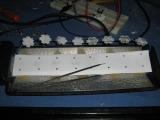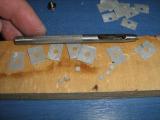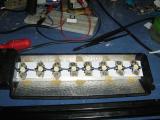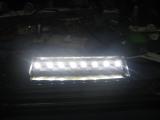PAGE 2 of 3
The devil is hidden in the detail
I ran the first test and strangely only the first LED in series lit... Obviousely something is terrible wrong here. It did not take long to discover that the negative pad on the LED star heat-sink is shorted with its bottom side. So, the current goes through the first LED, and then instead of travelling through the other LEDs is finds its quickest path through the aluminum base to the negative pad of the last LED and hen back to the driver... Bummer.
I had to give a simple and quick solution...
 |
 |
 |
 |
| I placed a piece of paper between the LEDs and the aluminum bar to isolate the bottom surface of the star heat-sink |
I had some TO220 heatsink isolators which i used to make isolating washers for the screws |
I placed the LEDs onto the paper and screw them down to the aluminum profile using also the isolating washers |
Tadaaaaaaaaaa |
And, let there be light!
Things to do for the future... (AKA ToDo list)
1. Make a 220V SMPS constant current driver
2. Get some 45 or 60 degrees Lenses because the light is scattered all around with those 120 degrees LEDs
Comments
At 16 October 2013, 16:34:59 user santosh wrote: [reply @ santosh]sir,i want to design an led driver to drive 25nos. of 1w led please help me..pls
At 6 June 2013, 16:31:48 user Larry wrote: [reply @ Larry]Nice refurb. I noticed the shorting of the screws before I went to the second page and saw you solved that problem. I'm getting into the new high power LED stuff myself and found an easy solution to the washer for mounting screw problem. Use rubber hose and cut into 1/8" lengths with a pair of wire cutters. Very fast to make lots of rubber (non-conductive) washers. Use 1/8" diameter hose (or whatever size screws you are using, although all star-based LED's I have seen you must use #4 or smaller screws) Viton (400 degrees F max) or Norprene (200 degrees F max) hose.
keep up the good work.
At 17 January 2013, 21:30:13 user Metalshrine wrote: [reply @ Metalshrine]@Giorgos Lazaridis You are right. I guess I was too tired that time. However, congratulations for the lamp.
At 2 January 2013, 9:20:11 user Giorgos Lazaridis wrote: [reply @ Giorgos Lazaridis]@Metalshrine 1/sqr2 = 0.707 so it is the same
At 31 December 2012, 8:54:34 user Metalshrine wrote: [reply @ Metalshrine]Man, I think you have a mistake at the beginning. Vrms*sqr2=Vpp. At least this is the way I know it.
At 10 December 2012, 18:00:40 user spi wrote: [reply @ spi]I have the exact same lamp and i was thinking the exact same thing. Nice work! |
|
 HOT in heaven! HOT in heaven!

|
|

 Home
Home
 Projects
Projects
 Experiments
Experiments
 Circuits
Circuits
 Theory
Theory
 BLOG
BLOG
 PIC Tutorials
PIC Tutorials
 Time for Science
Time for Science
 Contact
Contact
 Forum
Forum
 Projects
Projects
 Experiments
Experiments
 Circuits
Circuits
 Theory
Theory
 BLOG
BLOG
 PIC Tutorials
PIC Tutorials
 Time for Science
Time for Science
 RSS
RSS